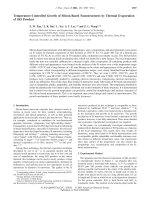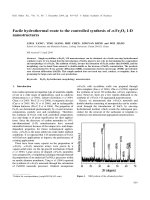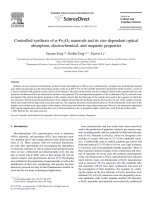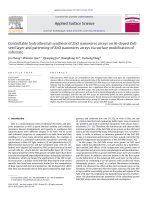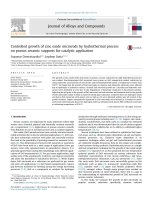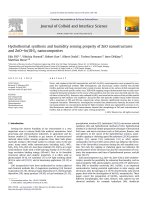controlled synthesis of 1d zno nanostructures via hydrothermal
Bạn đang xem bản rút gọn của tài liệu. Xem và tải ngay bản đầy đủ của tài liệu tại đây (2.11 MB, 7 trang )
Controlled
synthesis
of
1D
ZnO
nanostructures
via
hydrothermal
process
Di
Liu,
Yanfang
Liu,
Ruilong
Zong,
Xiaojuan
Bai,
Yongfa
Zhu
*
Department
of
Chemistry,
Tsinghua
University,
Beijing
100084,
PR
China
1.
Introduction
ZnO
is
a
potentially
useful
semiconductor
with
a
direct
band-
gap
of
3.37
eV
and
can
be
used
as
photocatalyst
to
destroy
the
organic
pollutants.
In
some
cases,
ZnO
may
exhibit
a
better
efficiency
than
TiO
2
in
photo-catalytic
degradation
for
some
dyes
[1].
Because
the
electrical,
optical
and
some
other
properties
of
nanocrystals
were
governed
by
the
sizes
and
shapes
[2],
much
works
have
been
done
to
fabricate
ZnO
nanostructures
of
controlled
shape
and
size.
Generally,
in
comparison
to
0D
nanostructures,
1D
nanostructures
have
less
grain
boundary,
surface
defect,
dislocation
etc.,
thus
leading
to
more
effective
carrier
transport
[3].
Therefore,
the
methods
to
fabricate
one-
dimensional
(1D)
ZnO
such
as
nanowires
and
nanorods
have
received
the
most
attention,
for
example,
the
high-temperature
physical
evaporation
[4],
the
template-induced
method
[5–7],
hydrothermal
synthesis
[8–11],
reverse
micelle
[12],
biominerali-
zation
method
[13],
precursors
induced
solution
phase
method
[14],
direct
calcination
of
zinc
acetate
[15]
were
used.
Among
all
these
methods,
the
simple
solution
synthesis,
by
thermal
treatment
of
the
reactant
in
different
solvents,
may
be
the
most
simple
and
effective
way
to
prepare
sufficiently
crystallized
materials
at
relatively
low
temperatures
[16–18].
Therefore,
it
is
necessary
to
elucidate
the
relationship
between
reaction
condi-
tions
and
ZnO
morphologies
and
explore
an
effective
and
simple
route
to
control
the
morphology
of
ZnO
for
practical
applications.
This
work
focuses
on
the
synthesis
of
1D
ZnO
with
the
hexagonal
system
wurtzite-type
structure.
A
wide
range
of
ZnO
nanostructures
with
various
shapes
were
obtained
by
adjusting
synthetic
parameters
such
as
precursor
concentration,
reaction
time,
solvent,
reaction
temperature,
annexing
agent,
alkali
source.
The
mechanisms
of
reaction
of
the
formation
of
ZnO
with
various
morphology
and
structure
are
investigated
respectively.
2.
Materials
and
methods
2.1.
Chemicals
All
chemicals
(analytical-grade
reagents)
were
purchased
from
Beijing
Chemicals
Co.
Ltd.
and
used
without
further
purification.
2.2.
The
preparation
of
ZnO
micro/nanostructures
ZnO
nanostructures
were
synthesized
by
using
a
simple
hydrothermal
method.
A
certain
amount
of
zinc
nitrate
hexahy-
drate
(Zn(NO
3
)
2
Á6H
2
O)
and
some
corresponding
amount
of
alkali
were
mixed
with
solvent
composed
of
distilled
water
and
ethanol
(v/v
=
1:2).
It
is
noteworthy
that
the
solvents
for
samples
in
Fig.
3
are
water-methanol
(v/v
=
1:2),
water-alcohol
(v/v
=
1:2),
water-n-
butyl
alcohol
(v/v
=
1:2)
respectively.
The
mixture
was
stirred
for
two
hours.
Then
a
certain
amount
of
annexing
agent
(CTAB/
PEG400)
and
were
transferred
into
the
mixture
under
stirring.
Materials
Research
Bulletin
49
(2014)
665–671
A
R
T
I
C
L
E
I
N
F
O
Article
history:
Received
13
December
2012
Received
in
revised
form
19
August
2013
Accepted
29
September
2013
Available
online
17
October
2013
Keywords:
A.
Nanostructures
A.
Semiconductors
B.
Chemical
synthesis
B.
Crystal
growth
A
B
S
T
R
A
C
T
ZnO
nanostructures
with
various
morphologies
and
sizes
were
successfully
prepared
via
a
hydrothermal
method.
The
influence
of
precursor
concentration,
reaction
time,
solvent,
reaction
temperature,
annexing
agent
and
alkali
source
on
the
morphology
and
structure
was
elucidated
systematically.
The
preferential
growth
of
ZnO
crystal
along
C-axis
direction
was
obvious
when
the
precursor
concentration
was
low.
A
balance
between
growth
and
dissolve
existed
during
the
process
of
forming
ZnO.
The
solvent
of
water-methanol
would
make
for
the
generation
of
products
with
a
big
size
and
regular
morphology.
The
adsorption
of
CTA
+
from
the
additive
of
cetyltrimethyl
ammonium
bromide
(CTAB)
and
hydroxyl
groups
from
polyethylene
glycol
(PEG400)
on
ZnO
would
slow
down
the
preferential
growth
rate
along
C-axis
direction,
leading
to
rod-like
products
with
smaller
aspect
ratios.
When
the
concentration
of
NaOH
was
increased
to
a
certain
degree,
the
growth
rate
of
ZnO
was
slower
than
the
decomposition
rate,
leading
to
appearance
of
irregular
grain-like
products.
ß
2013
Elsevier
Ltd.
All
rights
reserved.
*
Corresponding
author.
Tel.:
+86
10
62787601;
fax:
+86
10
62787601.
address:
(Y.
Zhu).
Contents
lists
available
at
ScienceDirect
Materials
Research
Bulletin
jo
u
rn
al
h
om
ep
age:
ww
w.els
evier.c
o
m/lo
c
ate/mat
res
b
u
0025-5408/$
–
see
front
matter
ß
2013
Elsevier
Ltd.
All
rights
reserved.
/>Next,
the
solution
mixture
was
pretreated
under
an
ultrasonic
water
bath
for
30
min
and
then
was
hydrothermally
treated
at
a
given
temperature
for
certain
time
in
a
Teflon-lined
autoclave.
After
the
reaction,
the
white
precipitate
was
collected
and
washed
several
times
with
distilled
water
and
pure
ethanol.
Finally,
ZnO
were
obtained
after
dried
at
80
8C
for
8
h.
A
series
of
condition-dependent
experiments
were
carried
out
to
investigate
the
growth
process
of
ZnO.
Ultrasonic
pretreatment
can
promote
the
generation
of
a
certain
number
of
active
nucleus,
so
all
experiments
in
this
work
adopted
the
ultrasonic
pretreat-
ment
operation
so
as
to
accelerate
reaction
process
[11,19].
The
reaction
parameters
for
each
series
were
summarized
in
Table
1.
2.3.
Characterizations
The
morphologies
and
dimensions
of
the
as-synthesized
ZnO
nanostructures
were
observed
with
transmission
electron
micros-
copy
(TEM)
by
a
JEOL
JEM
2100
electron
microscope
operated
at
an
accelerating
voltage
of
100
kV.
2.4.
Photocatalytic
experiments
The
photocatalytic
performance
of
the
as-prepared
samples
was
evaluated
by
photocatalytic
degradation
of
methylene
blue
(MB)
under
UV
light
irradiation.
The
samples
(25
mg)
were
dispersed
in
the
50
ml
MB
aqueous
solution
(3
Â
10
À5
M).
The
mixed
suspension
was
magnetically
stirred
for
0.5
h
in
the
dark
to
reach
an
adsorption–desorption
equilibrium.
Under
ambient
conditions
and
stirring,
the
mixed
suspensions
were
exposed
to
UV
irradiation
produced
by
a
300
W
high
pressure
Hg
lamp
with
the
main
wave
crest
at
365
nm.
At
certain
time
intervals,
2
ml
of
the
mixed
suspension
were
extracted
and
centrifugated
to
remove
the
photocatalyst.
The
degradation
process
was
monitored
by
measuring
the
absorption
of
MB
in
filtrate
at
664
nm
using
UV–vis
absorption
spectrometer.
3.
Results
and
discussion
ZnO
nanostructures
with
various
sizes
and
morphologies
were
obtained
with
different
precursor
concentration,
reaction
time,
solvent,
reaction
temperature,
annexing
agent,
alkali
source
etc.
The
detailed
effects
of
these
conditions
are
shown
in
the
following
paragraphs.
Determining
these
effects
will
be
helpful
to
further
extend
the
scope
of
the
hydrothermal
synthesis
method
employed
in
this
work.
3.1.
Effects
of
precursor
concentration
Fig.
1
shows
the
TEM
images
of
the
ZnO
prepared
with
different
precursor
concentrations.
When
the
precursor
concentration
was
high
(>0.0167
M),
the
product
had
a
flake-like
structure
(Fig.
1a
and
b).
Long
spindle-like
products
formed
when
the
precursor
concentration
decreased
below
0.0067
M
(Fig.
1c
and
d).
The
diameters
were
in
the
range
of
180–370
nm
and
140–300
nm,
and
the
aspect
ratios
were
in
the
range
of
6–13
and
12–15
for
the
products
prepared
at
0.0067
M
and
0.001
M,
respectively.
It
is
considered
that
the
crystal
prefers
lateral
growth
when
the
zinc
source
is
abundant,
leading
to
the
appearance
of
flake-like
structure.
The
formation
of
the
spindle-like
structure
can
be
attributed
to
the
reactant
shortage
and
subsequent
limited
growth
during
the
late
period
of
the
reaction.
Because
the
preferential
growth
of
ZnO
crystal
is
along
C-axis
direction,
the
(0
0
0
1)
crystal
plane
which
has
a
rapid
growth
rate
would
be
covered
gradually,
forming
a
cuspate
shape
structure.
With
the
concentration
further
reduced,
diameter
of
rods
decreased
and
the
aspect
ratio
increased.
The
above
results
show
that
when
the
precursor
concentration
is
low,
the
preferential
growth
of
ZnO
crystal
along
C-axis
direction
is
obvious.
At
this
time,
because
of
the
low
concentration
of
reactants,
the
reaction
rate
is
slow
and
the
distinction
of
the
probability
that
growth
units
combine
to
each
crystal
plane
is
also
significant.
Then
the
crystal
grain
presents
a
polar
growth
trend,
leading
to
1D
morphology.
Our
proposition
is
consistent
with
the
previous
conclusion
[20].
At
the
same
time,
due
to
the
strict
monomer
diffusion,
the
crystal
growth
rate
is
restricted,
thus
the
product
size
is
much
smaller.
3.2.
Effects
of
reaction
time
TEM
images
of
ZnO
obtained
with
different
reaction
time
are
shown
in
Fig.
2.
There
exist
some
short
columnar
products
at
the
initial
stage
of
the
reaction
(1
h).
Their
average
diameters
are
in
the
range
of
180–300
nm.
It’s
important
to
note
that
some
hexagon
thin
slices
formed
within
1
h.
An
hour
later,
the
hexagon
thin
slices
began
to
deform,
the
short
columnar
structure
coarsened
and
lengthened
at
the
same
time.
The
aspect
ratio
increased
a
little
since
it
grew
faster
in
the
length
direction
than
in
the
diameter.
The
hexagon
thin
slice
seemed
to
dissolve
away
after
5
h.
Then
the
hexagon
slices
gradually
disappeared
when
the
reaction
time
is
prolonged
and
the
diameters
of
nanorods
increased
as
the
reaction
time
increased
from
5
h
to
16
h.
Based
on
Fig.
2,
it
is
concluded
that
there
exists
a
balance
of
growth-dissolve
during
the
formation
process
of
ZnO.
It
is
considered
that
the
crystal
prefers
lateral
growth
at
the
initial
stage
of
the
reaction
due
to
the
abundant
zinc
source,
leading
to
the
appearance
of
the
complete
hexagon
section
slice.
As
reaction
time
increases,
the
hexagon
thin
slices
gradually
dissolve
and
then
disappear,
the
short
columnar
structure
further
coarsens,
whereas
the
aspect
ratio
slowly
increases.
3.3.
Effects
of
solvent
All
products
shown
in
Fig.
3
present
flake-like
shape
when
the
adding
amount
of
additive
(PEG400)
was
set
at
5
ml
and
the
precursor
concentration
was
0.067
M.
ZnO
prepared
in
the
solvent
of
water-methanol
has
a
relatively
regular
morphology
which
is
close
to
rectangle
shape
with
the
shorter
length
of
about
500
nm.
However,
some
small
irregular
pieces
with
average
length
of
several
dozens
of
nanometers
and
smaller
length–width
ratios
were
obtained
when
the
solvent
changed.
These
observations
demonstrate
that
solvent
plays
an
important
role
in
the
morphology
of
product.
This
may
be
caused
by
the
different
Table
1
The
experimental
conditions
of
ZnO
nanostructure
preparation.
Designation
n(Zn
2+
):n(HMT)
C(Zn
2+
)
Solvent
(V
H2O
:V
ethanol
)
Reaction
temperature
(8C)
Reaction
time
(h)
Samples-Fig1
1:1
1:2
100
24
Samples-Fig2
1:1
0.0067
M
1:2
100
Samples-Fig3
1:1
0.067
M
150
24
Samples-Fig4
1:1
0.0067
M
1:2
16
Samples-Fig5/6
1:1
0.0067
M
1:2
100
16
Samples-Fig7
0.050
M
1:2
150
16
D.
Liu
et
al.
/
Materials
Research
Bulletin
49
(2014)
665–671
666
Fig.
1.
TEM
images
of
ZnO
with
different
precursor
concentrations:
(a)
0.067
M;
(b)
0.0167
M;
(c)
0.0067
M
and
(d)
0.001
M.
Fig.
2.
TEM
images
of
ZnO
samples
with
different
reaction
time:
(a)
and
(b)
1
h;
(c)
and
(d)
2
h;
(e)
5
h;
(f)
8
h;
(g)
12
h
and
(h)
16
h.
D.
Liu
et
al.
/
Materials
Research
Bulletin
49
(2014)
665–671
667
properties
of
each
solvent
such
as
polarity
of
solvent,
saturated
vapor
pressure,
adhesion
coefficient,
dissolving
capacity
to
salt
or
metal
ions,
solvability
and
so
forth
[18].
Firstly,
the
solvation
of
PEG400
is
obvious
when
water-methanol
is
used
as
solvent
because
of
its
strong
polarity.
When
the
PEG400
molecules
are
surrounded
by
solvent
molecules,
their
adsorption
on
the
surface
of
ZnO
grain
will
decrease.
In
addition,
the
solute
is
difficult
to
disperse,
thus
large
sheet-like
products
with
complete
morphol-
ogies
are
easy
to
form
in
relatively
concentrated
solute.
Secondly,
methanol
has
a
low
boiling
point,
and
the
reaction
temperature
in
this
experiment
has
reached
its
boiling
point.
As
a
result,
the
collision
and
coalescence
of
nucleuses
are
significant
in
the
violently
boiling
solution,
leading
to
product
with
large
size.
On
the
contrary,
ethanol
and
n-butyl
alcohol
both
have
lower
polarity
and
higher
boiling
points
compared
to
methanol,
thus
at
the
initial
stage
of
nucleation
when
the
temperature
is
below
the
boiling
point,
the
collision
and
coalescence
of
nucleuses
and
the
solvation
of
PEG400
are
not
strong
and
the
dispersion
of
solute
is
good,
thus
well-scattered
small
pieces
were
obtained.
3.4.
Effects
of
reaction
temperature
In
Fig.
4,
the
aspect
ratio
of
ZnO
obtained
at
different
reaction
temperature
has
little
change.
However,
the
aspect
ratio
of
product
decreases
and
the
quantity
of
long
spindle-like
product
decreases
at
lower
temperature,
which
indicates
that
the
growth
rate
along
C-axis
direction
weakens.
It
is
also
can
be
observed
that
when
the
reaction
temperature
is
reduced,
the
hydrolysis
velocity
(that
is
the
rate
of
releasing
OH
À
)
of
hexamethylenetetramine
(HMT)
slows
down,
the
property
of
crystal
and
growth
integrity
of
product
both
weaken.
3.5.
Effects
of
annexing
agent
Scheme
1
is
a
schematic
procedure
to
prepare
ZnO
nanos-
tructures
in
the
presence
of
annexing
agent.
As
shown
in
Scheme
1,
CTA
+
and
hydroxyl
groups
coming
from
the
additive
of
CTAB
and
PEG400
respectively
can
adsorb
on
the
surface
of
ZnO
crystal
grain
through
the
electrostatic
attraction
effect
with
the
growth
units
or
zinc
ion
in
solution.
However,
based
on
the
results
reported
before,
the
growth
rate
of
each
crystal
plane
of
ZnO
is
different
[21].
The
more
active
the
crystal
plane
is,
the
more
growth
units
or
zinc
ions
it
would
grasp.
As
a
result,
the
clapping
role
acted
by
CTAB
or
PEG400
molecules
realizes
the
regulation
of
crystal
growth.
Figs.
5
and
6
shows
TEM
micrographs
of
the
ZnO
crystals
grown
in
the
aqueous
solutions
with
certain
amount
of
additive.
As
shown
in
Fig.
5,
all
products
prepared
with
or
without
the
additive
of
CTAB
exhibit
rod-like
structure.
It’s
worth
noting
that
the
aspect
ratio
of
the
product
prepared
free
of
additive
is
about
6–13.
However,
the
aspect
ratio
decreases
to
2–5
after
adding
some
amount
of
CTAB.
At
the
same
time,
when
the
adding
amount
is
more
than
0.2
mmol,
the
diameters
of
the
products
increased
to
1
m
m.
CTAB
is
a
cationic
surfactant
which
can
be
completely
hydrolyzed
in
water
or
ethanol.
The
cation
generated
from
hydrolysis
has
a
tetragonal
structure
with
a
hydrophobic
long
chain
tail,
therefore
there
is
an
ion
pair
of
the
growth
elementary
Zn(OH)
4
2À
and
CTA
+
.
Thus
it
is
Fig.
4.
TEM
images
of
ZnO
prepared
at
different
reaction
temperature:
(a)
and
(b)
100
8C;
(c)
and
(d)
80
8C.
Fig.
3.
TEM
images
of
ZnO
prepared
in
different
solvent:
(a)
water-methanol;
(b)
water-alcohol;
(c)
water-n-butyl
alcohol.
D.
Liu
et
al.
/
Materials
Research
Bulletin
49
(2014)
665–671
668
considered
that
the
surfactant
molecules,
which
can
be
adsorbed
on
the
surface
of
zinc
oxide
during
the
crystallization
process,
have
the
following
two
roles:
structural
directing
agent
and
protectant
for
preventing
product
from
gathering.
CTAB
may
also
act
as
the
transmission
medium
or
the
modifying
agent
for
the
small
crystal
nucleus
in
the
initial
solution.
The
surfactant
molecules
adsorbed
on
the
surface
of
crystal
nucleus
can
be
seen
as
links
for
small
crystal
nucleus
gathering
into
crystal
nucleus
cluster
[22].
As
can
be
seen
from
Fig.
5(b–e),
CTAB
plays
a
role
of
limiting
domain,
and
the
CTA
+
is
much
easier
to
adsorb
on
the
active
(0
0
0
1)
crystal
plane
due
to
the
electrostatic
interaction
as
shown
in
Scheme
1(a).
Thus
the
preferential
growth
rate
along
C-axis
direction
is
weakened
to
some
extent,
leading
to
relatively
uniform
growth
rates
of
the
crystal
planes.
Fig.
6
shows
that
the
diameters
of
products
are
in
the
range
of
150–800
nm
when
the
adding
amount
of
PEG400
changes
from
Scheme
1.
Schematic
illustration
of
the
proposed
formation
mechanisms
of
ZnO.
Fig.
5.
TEM
images
ZnO
prepared
with
different
adding
volume
of
CTAB:
(a)
0;
(b)
0.02
mmol;
(c)
0.1
mmol;
(d)
0.2
mmol
and
(e)
0.4
mmol.
D.
Liu
et
al.
/
Materials
Research
Bulletin
49
(2014)
665–671
669
0
ml
to
2
ml.
However,
when
the
adding
amount
is
increased
to
5
ml,
the
diameter
of
the
product
increases
to
several
microns
and
the
aspect
ratio
decreases
obviously.
It
is
also
found
that
with
the
adding
amount
of
PEG400
increased,
long
spindle-like
structure
gradually
reduces,
quite
to
the
opposite,
long
columnar
structure
increases.
As
an
organic
polymer
with
a
long
non-polar
carbon
chain,
PEG
is
often
used
as
surfactant
to
control
the
growth
of
nanocrystals.
The
atom
O
in
the
entire
long
PEG400
molecule
has
coordination
abilities
with
metal
ions,
thus
it
has
a
relatively
strong
electrostatic
attraction
to
Zn
2+
.
Then
the
adsorption
of
PEG400
on
the
surface
of
ZnO
crystal
grain
would
make
the
activity
of
ZnO
particles
greatly
reduced
[9].
The
corresponding
illustration
can
be
seen
in
Scheme
1(b).
It
can
be
seen
in
general
that
PEG400
has
a
similar
function
as
CTAB
which
is
different
only
in
the
ways
of
adsorption
because
of
their
different
molecular
structures.
Solvation
effect
caused
by
pure
water
will
weaken
the
adsorption
of
PEG400
molecules
on
the
surface
of
ZnO
crystal
grain.
Thus,
water-ethanol
(V:V
=
1:2)
was
selected
as
solvent
to
avoid
the
solvation
effect.
3.6.
Effects
of
alkali
source
TEM
micrographs
of
ZnO
prepared
with
different
concentration
of
NaOH
are
shown
in
Fig.
7.With
the
molar
ratio
of
Zn
2+
to
NaOH
Fig.
6.
TEM
images
of
ZnO
with
different
adding
volume
of
PEG400:
(a)
0;
(b)
0.2
ml;
(c)
1
ml;
(d)
2
ml
and
(e)
5
ml.
Fig.
7.
TEM
images
of
ZnO
prepared
with
different
concentration
of
NaOH:
(a)
0.25
M
(Zn
2+
:NaOH
=
1:5);
(b)
0.4
M
(Zn
2+
:NaOH
=
1:8)
and
(c)
0.6
M
(Zn
2+
:NaOH
=
1:12).
D.
Liu
et
al.
/
Materials
Research
Bulletin
49
(2014)
665–671
670
increased
from
1:5
to
1:12,
the
morphology
of
product
turns
gradually
from
rod-like
to
grain-like
shape.
Based
on
the
crystal
growth
characteristics
of
ZnO,
the
product
presents
column-like
morphology.
When
the
pH
rises,
the
supersaturation
of
solution
which
can
affect
the
size
of
critical
nucleus
is
bigger,
thus
making
the
size
of
crystal
nucleus
much
smaller
at
the
stage
of
nucleation
and
leading
to
the
formation
of
products
with
small
size.
ZnO
is
a
kind
of
amphoteric
oxide,
so
when
the
concentration
of
NaOH
is
high,
the
growth
rate
of
ZnO
may
be
smaller
than
the
decomposi-
tion
rate
[23].
Thus
the
products
prepared
with
high
concentration
of
NaOH
present
irregular
grain-like
structure
due
to
the
larger
decomposition
rate
of
(0
0
0
1)
crystal
plane.
The
growth
of
crystal
experiences
a
process
of
dissolution-crystallization.
3.7.
Photocatalytic
activity
It
is
well
known
that
ZnO
has
been
used
as
a
semiconductor
photocatalyst
for
the
degradation
of
pollutants.
The
photocatalytic
activity
of
samples
in
Fig.
1
in
the
degradation
of
well-known
organic
dye
MB
was
presented
in
Fig.
8.
The
photocatalytic
properties
of
samples
in
Fig.
1,
from
Fig.
1a
to
d,
show
a
trend
which
is
decreased
at
first
and
then
increased.
From
the
comparison
between
Fig.
1a
and
b,
it
can
be
seen
that
the
former
has
a
better
crystalline
performance
which
also
means
that
it
would
have
less
bulk
defects.
The
bulk
defects
are
usually
seen
as
recombination
centers
of
photo-generated
electrons
and
holes.
Thus,
Fig.
1b
is
supposed
to
have
a
higher
probability
of
the
recombination
of
the
photo-generated
electron/hole
pairs
in
comparison
to
sample
a,
resulting
in
a
lower
photocatalytic
activity.
Fig.
1c
and
d
with
smaller
crystal
sizes
and
larger
specific
surface
area
were
obtained
by
further
reduce
the
concentration
of
reactants.
The
large
surface
area
supplies
more
active
sites
to
adsorb
MB,
and
then
facilitates
the
diffusion
and
mass
transportation
of
MB
molecules
and
hydroxyl
radicals
during
the
photochemical
reaction.
Moreover,
the
structures
of
nanoscale
favor
the
movement
or
transfer
of
electrons
and
holes
generated
inside
the
crystal
to
the
surface
[24],
which
also
helps
to
enhance
the
photocatalytic
activity
of
Fig.
1c
and
d
to
some
degree.
The
photocatalytic
activity
of
ZnO
is
also
strongly
dependent
on
the
surface
orientation
of
the
nanocrystals
which
could
result
in
orientation-dependent
charge-transfer
processes
[25,26].
Thus,
as
for
the
hexagonal
ZnO
nanorods
(Fig.
1c
and
d),
their
regular
surface
orientation
with
larger
emergences
of
{1
0
1
0}
and
{0
0
0
1}
surfaces
would
be
propitious
to
the
separation
of
the
photo-induced
electrons
and
holes,
leading
to
relatively
higher
photocatalytic
efficiencies.
However,
in
comparison
to
Fig.
1c
and
d
has
a
smaller
size
and
a
larger
specific
surface
area
which
result
in
a
higher
photocatalytic
performance.
4.
Conclusions
Summarizing,
ZnO
nanostructures
with
various
well-defined
morphologies,
such
as
columnar-,
long
spindle-,
flake-
and
grain-
like
samples
have
been
successfully
synthesized
by
adjusting
synthetic
parameters.
A
possible
mechanism
of
the
growth
process
of
the
ZnO
nanostructures
under
different
conditions
has
been
elucidated
systematically.
The
controllable
fabrication
also
pro-
vides
a
chance
for
studying
the
morphology-dependent
properties
of
ZnO
micro/nanocrystals.
Besides,
a
growth
mechanism
of
the
influence
of
surfactants
on
the
growth
of
crystal
was
discussed
in
detail.
Acknowledgments
This
work
was
partly
supported
by
the
Chinese
National
Science
Foundation
(20925725,
21373121)
and
National
Basic
Research
Program
of
China
(2013CB632403)
and
National
High
Technology
Research
and
Development
Program
of
China
(2012AA062701)
and
Special
Project
on
Innovative
Method
from
the
Ministry
of
Science
and
Technology
of
China
(2009IM030500).
References
[1]
B.
Dindar,
S.
Icli,
J.
Photochem.
Photobiol.
A:
Chem.
140
(2001)
263–268.
[2]
C.M.
Lieber,
Solid.
State.
Commun.
107
(1998)
607–616.
[3]
G.R.
Li,
T.
Hu,
G.L.
Pan,
T.Y.
Yan,
X.P.
Gao,
H.Y.
Zhu,
J.
Phys.
Chem.
C
112
(2008)
11859–11864.
[4]
M.S.
Arnold,
P.
Avouris,
Z.W.
Pan,
Z.L.
Wang,
J.
Phys.
Chem.
B
107
(2003)
659–663.
[5]
L.
Vayssieres,
K.
Keis,
J.
Phys.
Chem.
B
105
(2001)
3350–3352.
[6]
W.I.
Park,
D.H.
Kim,
S.W.
Jung,
G.C.
Yi,
Appl.
Phys.
Lett.
80
(2002)
4232–4234.
[7]
L.
Vayssieres,
Adv.
Mater.
15
(2003)
464–466.
[8]
J.H.
Choy,
E.S.
Jang,
J.H.
Won,
Appl.
Phys.
Lett.
84
(2004)
287–289.
[9]
Z.Q.
Li,
Y.J.
Xiong,
Y.
Xie,
Inorg.
Chem.
42
(2003)
8105–8109.
[10]
J.M.
Wang,
L.
Gao,
J.
Mater.
Chem.
13
(2003)
2551–2554.
[11]
B.
Liu,
H.C.
Zeng,
J.
Am.
Chem.
Soc.
125
(2003)
4430–4431.
[12]
Z.Q.
Li,
Y.
Xie,
Y.J.
Xiong,
R.
Zhang,
W.
He,
Chem.
Lett.
32
(2003)
760–761.
[13]
Z.R.
Tian,
J.A.
Voigt,
J.
Am.
Chem.
Soc.
124
(2002)
2954–12955.
[14]
L.
Biao,
S.H.
Yu,
F.
Zhang,
L.J.
Li,
Q.
Zhang,
L.
Ren,
K.
Jiang,
J.
Phys.
Chem.
B
108
(2004)
4338–4341.
[15]
C.G.
Tian,
Q.
Zhang,
A.P.
Wu,
M.J.
Jiang,
Z.L.
Liang,
B.J.
Jiang,
H.G.
Fu,
Chem.
Commun.
48
(2012)
2858–2860.
[16]
X.
Wang,
Y.D.
Li,
Inorg.
Chem.
45
(2006)
7522–7534.
[17]
B.M.
Wen,
Y.Z.
Huang,
J.J.
Boland,
J.
Phys.
Chem.
C
112
(2008)
106–111.
[18]
J.
Zhang,
L.D.
Sun,
Chem.
Mater.
14
(2002)
4172–4177.
[19]
Z.
Wang,
X.F.
Qian,
J.
Yin,
Z.K.
Zhu,
Langmuir
20
(2004)
3441–3448.
[20]
W.J.
Li,
E.W.
Shi,
W.Z.
Zhong,
Z.W.
Yin,
J.
Cryst.
Growth
203
(1999)
186–196.
[21]
L.
Vayssieres,
N.
Beermann,
S.E.
Lindquist,
A.
Hagfeldt,
Chem.
Mater.
13
(2001)
233–235.
[22]
L.L.
Wu,
Y.S.
Wu,
W.
Lu,
H.Y.
Wei,
Y.C.
Shi,
Appl.
Surf.
Sci.
252
(2005)
1436–1441.
[23]
B.
Liu,
H.C.
Zeng,
Langmuir
20
(2004)
4196–4204.
[24]
W.W.
Wang,
Y.J.
Zhu,
L.X.
Yang,
Adv.
Funct.
Mater.
17
(2007)
59–64.
[25]
E.S.
Jang,
J.H.
Won,
S.J.
Hwang,
J.H.
Choy,
Adv.
Mater.
18
(2006)
3309–3312.
[26]
N.
Kislov,
J.
Lahiri,
H.
Verma,
D.Y.
Goswami,
E.
Stefanakos,
M.
Batzill,
Langmuir
25
(2009)
3310–3315.
Fig.
8.
Photocatalytic
degradation
of
MB
in
the
presence
of
(A)
Sample-Fig.
1a,
(B)
Sample-Fig.
1b,
(C)
Sample-Fig.
1c,
(D)
Sample-Fig.
1d.
C0
and
C
represent
initial
MB
concentration
and
evolution
of
MB
concentration
during
photodegradation,
respectively.
D.
Liu
et
al.
/
Materials
Research
Bulletin
49
(2014)
665–671
671
